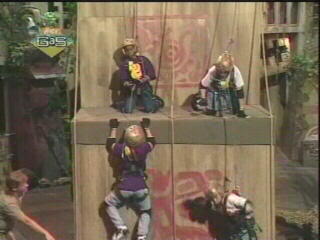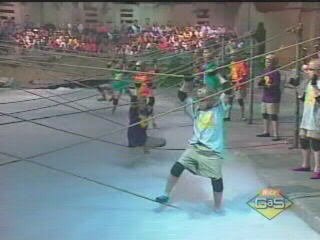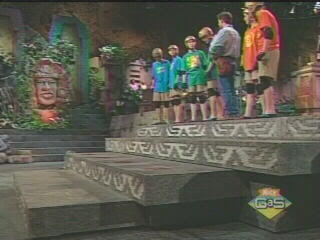Through Legends' three years on the air, the way the game was played remained nearly identical to the first episode.
1. The Teams
In each episode, six teams of two kids each compete towards victory. These six teams are the Red Jaguars, the Blue Barracudas, the Green Monkeys, the Orange Iguanas, the Purple Parrots, and the Silver Snakes. Each team wore respective colored shirts with a matching yellow animal logo on the front. Each team consists of one boy and one girl aged 11-14, and they need to work together through difficult physical and mental tests to progress as far as possible in their respective episode.

2. The Moat
The first challenge is the Moat, a wide pool the contestants have to cross as quickly as possible using a particular method. The restrictions vary from episode to episode; sometimes the challenge is as simple as crossing the water on an inflatable "lily pad," while other times it requires negotiating massive fishing nets and "ancient Babylonian Wheels." The first four teams to cross the Moat and hit their color "gong" move on to the next round.

3. The Steps of Knowledge
In the Steps of Knowledge, Olmec, the animatronic stone-head co-host, tells the remaining four teams a story about the episode's artifact, around which the remaining challenges for each episode are themed. He then reveals the artifact's location in the Temple (described later) and begins to ask the players multiple-choice questions about the legend. To ring in, one player from a team stomps down on an "ancient stone marking" embedded in their platform. If that team's response is correct, they move down to the level below. If they answer incorrectly or run out of time, then the other teams get an opportunity to answer the question. If a question is answered incorrectly by two teams, it is discarded and another one is asked. In very rare occasions, a third team is allowed to answer after two incorrect answers have already been given. The first two teams to answer three questions correctly and make it to the bottom level of the Steps move onto the Temple Games.

4. The Temple Games
The Temple Games are a collection of minute-long physical contests the two remaining teams compete in to win Pendants of Life, which are later used in Olmec's Temple. There are three Temple Games, and each is explained by either host Kirk Fogg (in the first season of the show) or Olmec (in the second and third). The skills required in the Games vary dramatically from episode to episode, but every game is themed around the day's legend. The first two Temple Games are worth a half-Pendant of Life each and involve one participant from each team, while the third is worth a full Pendant of Life and requires both players from both teams. After the three Games, the team with the greater amount of pendants won advances to Olmec's Temple. If there is a tie, a quick tiebreaker round is played, where either Kirk Fogg or Olmec asks a final multiple-choice question regarding the day's legend and the first team to answer it correctly wins. In the first season, an incorrect answer automatically gave the other team the win by default. However, in later seasons, an incorrect answer only gave the other team an opportunity to answer. Although not mentioned in the show, there are six general categories of Temple Games. For more information on these six types, click here. Also note that, in rare occasions, a Temple Game may not be timed.

5. Olmec's Temple

